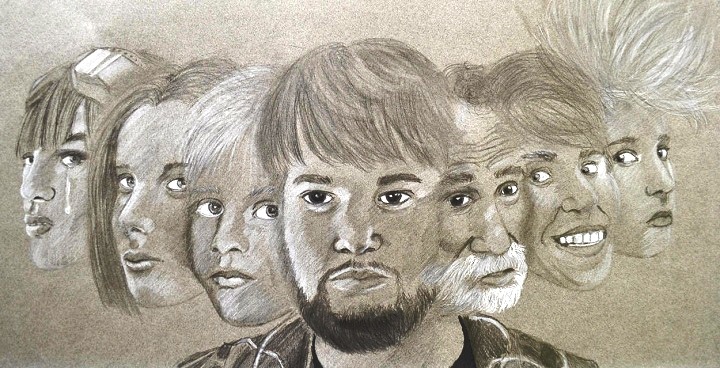What Is Multidimensional Disorder? Symptoms, Ways To Diagnose And Treat It
Multiple personality disorder is one of the complex mental disorders and various factors cause its formation.
These include childhood trauma (these traumas are usually severe and recurrent, with physical, sexual, and emotional abuse being more important and effective).
In the continuation of this article, join us to introduce you to multi-personality disorder.
This article gives you a brief overview on signs and symptoms, its causes, diagnosis and treatment.
What is Multiple Personality Disorder?
Perhaps the feeling of someone with a multi-personality disorder can be compared to someone who, while working, falls asleep for a moment. This feeling is not so strange to most of us, so most of us have a mild experience of this disorder. Our experience is limited to such situations. But multi-personality disease affects the mental mechanism in more advanced and severe stages. It causes a rupture, or loss of connection between thoughts, memories, feelings, and behaviors.

According to psychologists, a combination of several different factors causes bipolar or multipersonal disorder. One of these factors may be related to childhood trauma or trauma. Breaking away from the main character or resorting to other characters is actually the approach that a person with this disorder takes to cope with his condition. In other words, this person has had a very violent or painful experience that he or she is unable to consciously accept and tries to distance himself or herself from.
Is Multiple Personality Disorder Recognized as a Separate Disorder?
Understanding how different personalities are formed in a person is difficult, even for the most experienced professionals. This has led to a lack of consensus on treatments for multi-personality disease. Even some mental health professionals refer to it not as a separate disorder, but as a complication caused by other mental disorders such as borderline personality disorder (a patient with this disorder is on the verge of psychosis ; its symptoms can include emotional instability). , Temperament and behavior noted). Some see this disease as the result of an inability to cope with various issues and problems.
According to the category in the last edition of DSM (Diagnostic and Statistical Manual of Mental Disorders, published by the America Psychiatric Association and contains information about mental disorders and related issues.) Amnesia dissociative, depersonalization and derealization (changing attitudes toward The outside world and having feelings similar to the unreality of the outside world () are disorders that, along with multi-personality disease, are known as subsets of dissociative disorders.
What is the role of different characters?
Different personalities take on roles in a person’s existence to help him or her cope with complex life situations. In the early stages of diagnosis, an average of two to four different characters are identified, and during treatment, the number of these characters may reach thirteen to fifteen. There have also been cases in which more than a hundred different characters have been identified, although this is not uncommon. Environmental stimuli or life events are among the factors that change from one personality to another.
Symptoms of multiple personality disorder

The most obvious sign of multi-personality disorder is the appearance of two or more distinct personalities or identities in a person. A personality or identity that influences and dominates thoughts and behaviors. Effective and widespread forgetting of key personal information is another sign of this disorder.
In addition, a person with multiple personality disorder has unique memories for each of the characters that appear in him or her that are distinct from the memories of his or her other characters.
The age, gender, or race of each of these characters is different, and the behavior, mood, and manner of speaking will vary as each character appears. These characters sometimes take the form of imaginary people and sometimes animals.
The emergence of each character and its domination of behavior and thoughts is called “character change” (meaning that a character gives way to another character).
Some people change their personality every few seconds or minutes, and some, every few days. The psychotherapist may be able to respond to the patient’s needs by hypnotizing the patient.
Behavioral and mood symptoms
A person with bipolar disorder or multiple personality disorder may have other mental disorders in addition to these symptoms. Common symptoms of these disorders include: Depression ; Mood swings; Suicidal tendencies ; Sleep disorders ( insomnia , nightmares and sleepwalking ); Anxiety , panic (or panic attack) and phobia ; Alcohol and drug abuse; Obsessive and compulsive manners (involuntary); Symptoms similar to those of psychosis (such as visual and auditory hallucinations); Eating Disorders.
Other possible symptoms of polymorphism include headaches , forgetfulness, lack of time perception, ecstasy, and out-of-body experiences. Some people with the disorder tend to engage in self-harming, self-destructive, and even violent behaviors (both violence against themselves and violence against others).
For example, a person with multiple personality disorder may engage in activities that they would not normally do; Things like speeding or stealing money from a friend or employer.
In this situation, it is as if a force other than themselves is forcing him to do these things. Some people describe this feeling as follows: If we assume that their body is a car, they are its passengers instead of behind the wheel.
The process of diagnosing multiple personality disorder

Diagnosis of multiple personality disorder is time consuming. It is estimated that people with the disorder participate in various mental health treatment programs for about seven years before reaching the stage of diagnosis. This is normal, as the symptoms of multiple personality disorder are similar to many other mental disorders.
In addition, many people with the disorder suffer from borderline personality disorder or other mental disorders such as depression and anxiety, which make diagnosis much more difficult.
In the following, we will take a look at the criteria and criteria of the DSM handbook for diagnosing bipolar or multi-personality disease:
- The existence of two or more distinct identities or personalities in such a way that each of these personalities has a different perception and way of thinking about the person and the environment.
- Forgetfulness must be recognized; In such a way that a person has difficulty remembering everyday events, important personal information and / or events that have led to trauma.
- Multiple personality disorder must have caused distress or anxiety, or one or more major aspects of life affected by it.
- Anxiety and anxiety caused by cultural and religious habits should not be involved in the process of diagnosing the disorder.
- Psychological symptoms caused by the use of a particular substance (such as post-drug depression or alcohol-induced behavior) or other illness (such as partial or limited seizures ) should not be involved in the diagnosis.
The difference between multidimensional disorder and schizophrenia
The two disorders are often confused with each other, but there is a significant difference between them. Schizophrenia (or psychosis) is a dangerous mental disorder characterized by chronic (or recurrent) psychosis. The most obvious signs of schizophrenia are hallucinations (hearing or seeing unrealistic things) and delusions (believing or thinking irrationally).
Contrary to many people’s beliefs, people with schizophrenia do not have multiple personalities. Delusions are the most common symptom among these people and hallucinations, especially hearing unrealistic sounds, are seen in 50 to 75% of them.
People with both of these disorders (schizophrenia and multiple personality disorder) are at risk for suicide. Research shows that patients with multiple personalities have higher suicide rates than patients with other mental disorders.
The effect of multidimensional disease on life

Multiple personality disorder can change the lives of people with it, and this happens in several basic ways. We will take a look at these methods below:
- Decreased personality: The feeling of being separated from the body, which is why it is also called the experience outside the body;
- Metamorphosis: the feeling that the outside world is unreal or dark and out of reach;
- Forgetfulness: Inability to remember important personal information. This forgetfulness is so widespread that it cannot be called intermittent or ordinary forgetfulness. Patients may forget the subject during the conversation or forget the content of a meaningful conversation within a second;
- Identity Disorder or Change of Identity: In these situations, one cannot say with certainty who one is and in this sense, one feels distressed. A person who has difficulty defining life interests, political, religious, and social beliefs or career perspectives is an example of identity disorder. In addition, his feelings about time, place, or situation may change in a way that seems unusual.
It is now clear that the occurrence of these states does not necessarily indicate the existence of a distinct personality and rather indicates a kind of identity disintegration. Among these conditions, amnesia is more closely related to (more common) illness. Those who experience other states recall information about different aspects of their personal lives.
People with this disorder usually have a personality called a “host” and a personality that appears under a person’s real name. The strange thing is that the host character is not aware of the existence of other characters.
Who is at risk for multiple personality disorder?

Although it is not yet possible to speak with certainty about the causes of this disorder, research shows that it is a kind of psychological response to interpersonal and environmental pressures and stresses, and it has the greatest impact when these stresses are experienced in early childhood; That is, when emotional neglect or abuse disrupts how a child’s personality develops.
Nearly 99% of people with multiple personality disorder have repeatedly experienced unpleasant and often dangerous experiences during childhood (usually before the age of nine) that have caused them discomfort and annoyance.
Emotional inattention or emotional abuse is another factor that can lead to multi-personality disorder (even if there is no sexual or physical abuse).
Research shows that in families whose parents are unpredictable and create an atmosphere of fear and panic at home, their children are more likely to develop multi-personality disorders.
How common is multiple personality disorder?
According to statistics, between 0.01 and 1% of people have multiple personality disorder. If we take the disorder in its broadest sense, more than a third of people say they sometimes feel like they are watching themselves in a movie (which is probably an experience of disintegration or disintegration of identity), and 7% of people probably have some kind of They are multi-personality diseases and have not reached the stage of diagnosis.
Herschel Walker’s experiences of multiple personality disorder

One of the celebrities with multiple personality disorder is Herschel Walker, a former American football player. He says he has struggled with the disorder for years, but has only devoted the last eight years to its treatment.
Walker recently published a book about his experiences with the disorder, as well as a description of his suicide attempts. He talks about the loneliness and isolation he experienced from his childhood until he joined the professional league.
To cope with the feeling of this experience, he developed a stubborn personality that was not bothered by loneliness, was not afraid of anything, and wanted to vent the suppressed anger of loneliness.
These characters helped him to cope with the lack of loneliness, and in the meantime, other characters were formed to help him on his way to fame.
Walker now knows that these characters are part of and resulting from his multi-personality disorder; A disorder that was diagnosed in his youth (Herschel Walker is now 57 years old).
Treatment of multidimensional disease

There is no definitive cure for multidimensional disorder, however, participating in long-term treatment programs will be effective if the patient is committed enough. Effective therapies include speech therapy , psychotherapy, and hypnosis therapy ; Other adjunctive techniques, such as art therapy or movement therapy, can also be effective.
There is no cure for multiple personality disorder, so the mainstay of treatment will be based on psychological approaches. Treatment of other concomitant disorders, such as depression or the effects of certain drugs or medications, plays a key role in improving the patient’s general condition.
The symptoms of multiple personality disorder are often similar to the symptoms of other disorders such as anxiety and depression, so during the course of treatment of this disorder and in addition to the above approaches, medications are usually prescribed to treat other disorders.
As with most mental illnesses, treating, or at least coping with, the effects and consequences of multiple personality disorder is a continuous and time-consuming process, possibly lifelong.
Have you had any experience dealing with patients with this disorder? Have you ever felt that you might be suffering from this disease yourself?
If someone close to you has the disease, it’s a good idea to share your experience of dealing with them or living with them. Your message may be helpful to many.













